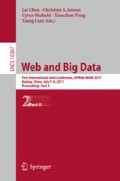Abstract
Article in the web is usually titled with a misleading title to attract the users click for gaining click-through rate (CTR). A clickbait title may increase click-through rate, but decrease user experience. Thus, it is important to identify the articles with a misleading title and block them for specific users. Existing methods just consider text features, which hardly produce a satisfactory result. User behavior is useful in clickbait detection. Users have different tendencies for the articles with a clickbait title. User actions in an article usually indicate whether an article is with a clickbait title. In this paper, we design an algorithm to model user behavior in order to improve the impact of clickbait detection. Specifically, we use a classifier to produce an initial clickbait-score for articles. Then, we define a loss function on the user behavior and tune the clickbait score toward decreasing the loss function. Experiment shows that we improve precision and recall after using user behavior.
Access this chapter
Tax calculation will be finalised at checkout
Purchases are for personal use only
References
Abbasi, A., Chen, H.: A comparison of fraud cues and classification methods for fake escrow website detection. Inf. Technol. Manag. 10(2), 83–101 (2009)
Biyani, P., Tsioutsiouliklis, K., Blackmer, J.: “8 amazing secrets for getting more clicks”: detecting clickbaits in news streams using article informality (2016)
Cessie, S.L., Houwelingen, J.C.V.: Ridge estimators in logistic regression. J. R. Stat. Soc. 41(1), 191–201 (1992)
Chakraborty, A., Paranjape, B., Kakarla, S., Ganguly, N.: Stop clickbait: detecting and preventing clickbaits in online news media. In: IEEE/ACM International Conference on Advances in Social Networks Analysis and Mining, pp. 9–16 (2016)
Chen, Y., Conroy, N.J., Rubin, V.L.: Misleading online content: recognizing clickbait as “false news”. In: ACM on Workshop on Multimodal Deception Detection, pp. 15–19 (2015)
Cortes, C., Vapnik, V.: Support-Vector Networks. Kluwer Academic Publishers, Boston (1995)
Cutler, A., Cutler, D.R., Stevens, J.R.: Random forests. Mach. Learn. 45(1), 157–176 (2004)
Friedman, J.H.: Greedy function approximation: a gradient boosting machine. Ann. Stat. 29(5), 1189–1232 (2001)
John, G.H., Langley, P.: Estimating continuous distributions in Bayesian classifiers. In: Eleventh Conference on Uncertainty in Artificial Intelligence, pp. 338–345 (1995)
Kolari, P., Java, A., Finin, T., Oates, T., Joshi, A.: Detecting spam blogs: a machine learning approach. In: National Conference on Artificial Intelligence and the Eighteenth Innovative Applications of Artificial Intelligence Conference, Boston, 16–20 July 2006
Lahiri, S., Mitra, P., Lu, X.: Informality judgment at sentence level and experiments with formality score. In: Gelbukh, A. (ed.) CICLing 2011. LNCS, vol. 6609, pp. 446–457. Springer, Heidelberg (2011). doi:10.1007/978-3-642-19437-5_37
Ntoulas, A., Najork, M., Manasse, M., Fetterly, D.: Detecting spam web pages through content analysis. In: World Wide Web Conference, pp. 83–92 (2006)
Potthast, M., Köpsel, S., Stein, B., Hagen, M.: Clickbait detection (2016)
Acknowledgements
This research is supported by National Natural Science Foundation of China (Grant No. 61375054), Natural Science Foundation of Guangdong Province Grant No. 2014A030313745, Basic Scientific Research Program of Shenzhen City (Grant No. JCYJ20160331184440545), and Cross fund of Graduate School at Shenzhen, Tsinghua University (Grant No. JC20140001).
Author information
Authors and Affiliations
Corresponding author
Editor information
Editors and Affiliations
Rights and permissions
Copyright information
© 2017 Springer International Publishing AG
About this paper
Cite this paper
Zheng, HT., Yao, X., Jiang, Y., Xia, ST., Xiao, X. (2017). Boost Clickbait Detection Based on User Behavior Analysis. In: Chen, L., Jensen, C., Shahabi, C., Yang, X., Lian, X. (eds) Web and Big Data. APWeb-WAIM 2017. Lecture Notes in Computer Science(), vol 10367. Springer, Cham. https://doi.org/10.1007/978-3-319-63564-4_6
Download citation
DOI: https://doi.org/10.1007/978-3-319-63564-4_6
Published:
Publisher Name: Springer, Cham
Print ISBN: 978-3-319-63563-7
Online ISBN: 978-3-319-63564-4
eBook Packages: Computer ScienceComputer Science (R0)

